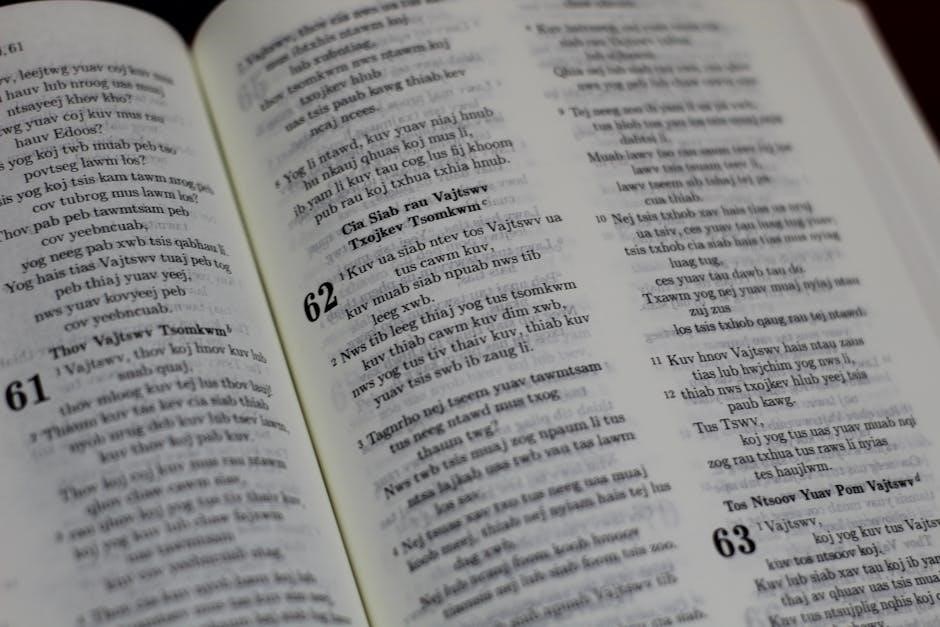
-
By:
- terrence
- No comment
to kill a mockingbird study guide
To Kill a Mockingbird, written by Harper Lee, is a timeless classic exploring racial injustice, moral growth, and the loss of innocence in the American South during the 1930s.
1.1 Overview of the Novel
To Kill a Mockingbird is set in the fictional town of Maycomb, Alabama, during the Great Depression. The story, narrated by Scout Finch, explores themes of racial injustice, courage, and moral growth. Central to the plot is the trial of Tom Robinson, a Black man falsely accused of raping a white woman. Atticus Finch, Scouts father and a moral pillar, defends Tom despite knowing he faces prejudice. The novel examines the loss of innocence as Scout and her brother Jem confront harsh realities. Through its exploration of human nature, the book remains a powerful commentary on justice and empathy, with Atticus embodying the ideals of courage and integrity. The reclusive Boo Radley adds depth, symbolizing kindness and redemption. The novel has won the Pulitzer Prize and is widely regarded as a classic of modern American literature.
1.2 Author Background
Harper Lee, born on April 28, 1926, in Monroeville, Alabama, drew inspiration from her hometown to craft To Kill a Mockingbird. She studied law at the University of Alabama but pursued writing in New York City. Lee’s experiences with racial tensions and small-town life influenced the novel. Her father, a lawyer, inspired Atticus Finch. Lee published the novel in 1960, earning the Pulitzer Prize in 1961. She remained private and dedicated to her craft, leaving a lasting legacy with her timeless exploration of justice and humanity.
1.3 Historical Context
To Kill a Mockingbird is set during the Great Depression in Maycomb, Alabama, reflecting the deep-seated racial tensions of the American South. The novel highlights the era’s strict social hierarchies and segregation, where African-Americans faced systemic injustice. The trial of Tom Robinson mirrors real-life scenarios of racial bias in the judicial system. Lee’s portrayal of these issues sparked critical discussions about equality and morality during the Civil Rights Movement, making the novel a significant commentary on the nation’s troubled past and ongoing struggle for justice.

Plot Summary
To Kill a Mockingbird follows Scout Finch and her family in Maycomb, Alabama, as her father, Atticus, defends Tom Robinson, a wrongly accused Black man, in a racially charged trial. Meanwhile, Scout and her brother Jem are fascinated by their reclusive neighbor Boo Radley, whose kindness ultimately saves them. The story explores racial injustice, courage, and the loss of innocence through Scout’s eyes.
2.1 Setting and Structure
The novel is set in Maycomb, Alabama, during the 1930s, a time of racial tension and economic hardship. The story unfolds through Scout Finch’s childhood perspective, blending humor and tragedy. Divided into two parts, the first focuses on Scout, Jem, and their fascination with Boo Radley, while the second centers on the trial of Tom Robinson. The trial becomes a pivotal event, exposing the town’s deep-seated prejudices and transforming Scout’s understanding of justice and humanity. The annual Maycomb trial also serves as a significant social event, reflecting the community’s values and divisions.
2.2 Main Events and Chapters
The novel spans three years, with key events unfolding in 31 chapters. Early chapters introduce Scout, Jem, and their fascination with Boo Radley, while later chapters focus on the trial of Tom Robinson. Chapters 17–21 detail the trial, highlighting racial tensions and injustice. The verdict sparks widespread reaction, leading to Tom’s death. Meanwhile, Bob Ewell’s revenge attempt on Scout and Jem in Chapter 28 marks a turning point, showcasing Boo Radley’s heroism. These events drive Scout’s moral growth and understanding of humanity, central to the novel’s themes and structure.
2.3 Climax and Resolution
The climax occurs when Bob Ewell attempts to harm Scout and Jem, but Boo Radley intervenes, saving them. In the resolution, Bob is found dead, and Sheriff Heck Tate covers up Boo’s involvement to protect him. Scout reflects on her father’s lessons, gaining a deeper understanding of kindness and empathy. The novel concludes with Scout imagining life from Boo’s perspective, symbolizing her maturity and the enduring message of moral integrity and compassion championed by Atticus throughout the story.

Major Characters
The novel features well-developed characters, including Scout Finch, Atticus Finch, Tom Robinson, and Boo Radley, each representing moral values and undergoing significant character development throughout the story.
3.1 Scout Finch
Scout Finch is the young, spirited narrator of To Kill a Mockingbird, whose curiosity and determination drive the story. As a child, she navigates the complexities of racial tensions and small-town life, learning valuable lessons about empathy and justice from her father, Atticus. Her journey from innocence to maturity is central to the novel, as she confronts harsh realities and develops a deeper understanding of the world around her.
3.2 Atticus Finch
Atticus Finch is the moral backbone of To Kill a Mockingbird, portrayed as a just and compassionate lawyer who defends the wrongly accused Tom Robinson. Despite knowing he’ll face prejudice, Atticus stands firm in his commitment to equality and justice. His defense of Tom showcases his belief in the legal system’s potential for fairness. Atticus also serves as a moral guide for his children, Scout and Jem, teaching them about empathy, courage, and doing what is right in the face of overwhelming opposition. His integrity earns him respect and admiration from the community.
3.3 Tom Robinson
Tom Robinson is a Black man falsely accused of raping Mayella Ewell, a white woman, in a deeply prejudiced community. Despite Atticus Finch’s strong defense, which exposes the inconsistencies in the prosecution’s case, Tom is convicted due to racial bias. His kindness and vulnerability make him a symbol of injustice. Tom’s death while attempting to escape prison further highlights the cruelty of the system. His story underscores the racial tensions and inequality prevalent in Maycomb, making him a poignant figure in the novel’s exploration of moral decay and societal prejudice.
3.4 Boo Radley
Boo Radley is a reclusive neighbor who sparks the children’s curiosity and fear. Despite his mysterious and intimidating reputation, Boo reveals a kind and protective nature, leaving gifts for Scout and Jem and rescuing them from Bob Ewell. His true character contrasts with the children’s initial perception, symbolizing the importance of understanding and empathy. Boo’s quiet heroism and gentle demeanor make him a symbol of redemption and the “mockingbird” of the story, someone who is misunderstood and unfairly judged by society.

Themes
To Kill a Mockingbird explores profound themes such as racial injustice, moral growth, and the loss of innocence. Atticus Finch’s defense of Tom Robinson highlights the deep-seated racism in Maycomb, while Scout’s journey reflects her growing understanding of empathy and justice. The novel emphasizes courage, as seen in Atticus’s steadfast commitment to righteousness despite societal opposition. It also underscores the importance of seeing things from others’ perspectives, a lesson Atticus imparts to Scout. These themes remain central to the novel’s enduring relevance and moral resonance.
4.1 Moral Growth and Education
Scout Finch’s journey through To Kill a Mockingbird is a powerful exploration of moral growth and education. As a young girl, Scout learns valuable lessons from her father, Atticus, about justice, empathy, and understanding. Through her interactions with characters like Tom Robinson, Boo Radley, and Calpurnia, Scout develops a deeper appreciation for the complexities of human nature. Atticus’s teachings emphasize the importance of “walking in someone’s shoes,” fostering Scout’s ability to see beyond prejudice and societal norms. This moral education shapes her into a compassionate and morally grounded individual, highlighting the novel’s focus on personal development and ethical awareness.
4.2 Racial Injustice
Racial injustice is a central theme in To Kill a Mockingbird, as seen through the wrongful accusation of Tom Robinson, a Black man, by Mayella Ewell, a white woman. Despite Atticus Finch’s strong defense, the deeply ingrained racial biases of the community lead to Tom’s conviction and eventual death. The novel highlights the systemic racism prevalent in the American South during the 1930s, where Black individuals were often denied fairness and justice. Through Tom’s trial and death, Harper Lee exposes the moral decay and inequality faced by African Americans, emphasizing the need for societal change and equality.
4.3 Courage and Heroism
Courage and heroism are exemplified through characters like Atticus Finch and Boo Radley. Atticus shows moral courage by defending Tom Robinson, despite knowing he’ll face prejudice and hostility. His commitment to justice and equality inspires his children to stand up for what is right. Boo Radley, initially feared, reveals his heroic nature by saving Scout and Jem from harm, demonstrating that true courage often lies in unexpected places. Through these characters, Harper Lee teaches that courage is not the absence of fear but the willingness to act despite it, leaving a lasting impact on Scout’s understanding of heroism.

Symbolism
The novel uses symbols like the mockingbird, Radley house, and the trial to represent innocence, prejudice, and injustice, highlighting moral lessons and societal issues.
5.1 The Mockingbird
The mockingbird symbolizes innocence and kindness, as it brings joy without harming others. In the novel, Tom Robinson and Boo Radley embody this symbol, representing victims of societal prejudice. Atticus explains that killing a mockingbird is a sin, highlighting the moral wrong of harming the innocent. This theme underscores the novel’s exploration of racial injustice and the loss of innocence, urging readers to empathize with those unfairly treated by society.
5.2 The Radley House
The Radley House serves as a symbol of mystery and fear, embodying the unknown and the townspeople’s prejudices. It is the residence of Boo Radley, a recluse shrouded in rumors. The house’s eerie presence fascinates Scout, Jem, and Dill, reflecting their childhood curiosity and the community’s penchant for gossip. Over time, the house transforms from a source of terror to a place of unexpected kindness, revealing the truth behind Boo’s isolation and challenging the children’s initial perceptions.
5.3 The Trial
The trial of Tom Robinson is a pivotal symbol of racial injustice in To Kill a Mockingbird. It exposes the deep-seated prejudice of Maycomb’s community, as Atticus Finch courageously defends Tom despite knowing the odds are against them. The trial highlights the flawed justice system, where Tom’s guilt is presumed due to his race. Atticus’s powerful defense reveals the lack of evidence, yet the jury delivers a guilty verdict, underscoring the societal blindness to racial inequality and injustice, making the trial a haunting reflection of human prejudice and moral failure.

Literary Devices
Harper Lee uses foreshadowing, metaphors, and similes to enrich the narrative. Scout’s childlike perspective adds depth, while symbols like the mockingbird highlight themes of injustice and innocence.
6;1 Narrative Style
The novel employs a unique narrative style, with Scout Finch recounting events both as a child and an adult. This dual perspective allows for a blend of naivety and retrospection, offering deep insights into themes like racial injustice and moral growth. The direct and straightforward storytelling is occasionally humorous, yet it tackles complex issues with clarity. The language evolves to reflect Scout’s maturation, showcasing her journey from innocence to understanding. This style enhances the emotional impact of the story, making it relatable and poignant for readers.
6.2 Foreshadowing
Harpert Lee masterfully uses foreshadowing to hint at future events, enriching the narrative. For instance, Alexandra warns Atticus about Bob Ewell’s vengeful nature, foreshadowing his attack on the children. Scout’s thoughts about Bob’s revenge and the mockingbird metaphor also signal impending tragedy. These subtle hints prepare readers for the novel’s dramatic climax, such as Tom’s death and Boo’s rescue. Lee’s use of foreshadowing enhances suspense and underscores the novel’s exploration of justice and morality, making the story both engaging and thought-provoking.
6.3 Language and Dialogue
Harpert Lee’s use of language and dialogue in To Kill a Mockingbird reflects the characters’ backgrounds and social dynamics. Scout’s childlike narrative contrasts with Atticus’s eloquent speeches, emphasizing moral lessons. Dialogue reveals racial tensions, as seen in exchanges between Atticus and Mayella. Lee employs dialects, like Calpurnia’s African-American Vernacular English, to highlight cultural differences. Rhetorical questions, such as Atticus’s courtroom inquiries, underscore the lack of evidence against Tom. The language and dialogue not only advance the plot but also deepen the exploration of justice, morality, and societal norms, making the novel emotionally resonant and thought-provoking.

The Trial
The trial of Tom Robinson is a pivotal moment in To Kill a Mockingbird, highlighting racial injustice. Despite Atticus’s compelling defense, the jury delivers a guilty verdict, reflecting deep-seated prejudice.
7.1 The Trial of Tom Robinson
The trial of Tom Robinson is a central event in To Kill a Mockingbird, showcasing racial tensions in Maycomb. Accused of raping Mayella Ewell, Tom, a Black man, faces a biased justice system. Atticus Finch defends Tom, emphasizing the lack of evidence and inconsistencies in Mayella’s story. Despite his efforts, the jury, influenced by prejudice, delivers a guilty verdict, highlighting the deep-seated racial inequality in the community. The trial profoundly affects Scout and Jem, exposing them to harsh realities of injustice.
7.2 The Verdict
The jury delivers a guilty verdict in Tom Robinson’s trial, despite overwhelming evidence of his innocence. This outcome reflects the deep racial prejudices of Maycomb’s community. Atticus, though disappointed, remains hopeful for justice through an appeal. The verdict deeply impacts Scout and Jem, who witness firsthand the injustices of the adult world. The community’s reaction further divides Maycomb, while Atticus’s moral stance earns him both admiration and scorn. The verdict underscores the novel’s themes of racial inequality and the loss of innocence.
7.3 Social Reaction
The guilty verdict sparks widespread reaction in Maycomb, highlighting deep racial tensions. While some, like Miss Maudie, support Atticus, others condemn him for defending a Black man. The Ewells, humiliated by the trial, vow revenge, leading to further conflict. Meanwhile, the community remains divided, with many refusing to acknowledge the injustice. The verdict underscores the pervasive prejudice in Maycomb, while also revealing moments of empathy and understanding among a few. The social reaction reflects the broader societal issues of racial inequality and moral decay.

Moral Lessons
To Kill a Mockingbird imparts profound moral lessons, emphasizing empathy, justice, and standing up for what is right despite societal opposition. Atticus teaches Scout to “walk in others’ shoes,” fostering understanding and compassion. The novel highlights the importance of moral courage and doing what is right, even in the face of overwhelming adversity.
8.1 Empathy and Understanding
Atticus Finch emphasizes the importance of empathy, teaching Scout to “walk in others’ shoes” to understand their perspectives. This lesson is central to the novel, as it challenges Scout and Jem to see beyond prejudice and societal norms. Through interactions with characters like Tom Robinson and Boo Radley, the children learn to value kindness and compassion. Empathy becomes a powerful tool for breaking down racial and social barriers, fostering a deeper understanding of human nature and morality.
8.2 Justice and Morality
Justice and morality are central themes in To Kill a Mockingbird, as Atticus Finch defends Tom Robinson despite knowing he’ll face prejudice. Atticus believes in doing what is right, even when societal norms oppose it. The novel highlights the discrepancy between legal justice and moral justice, as Tom’s guilty verdict reveals deep racial biases. Through Atticus’s unwavering commitment to fairness, Harper Lee illustrates the importance of standing up for what is morally right, even in the face of overwhelming opposition and injustice.
8.3 Doing What is Right
In To Kill a Mockingbird, Atticus Finch embodies the principle of doing what is right, even in the face of overwhelming opposition. His defense of Tom Robinson, despite knowing the outcome, shows moral courage. Atticus teaches Scout and Jem that true integrity lies in standing up for justice, regardless of societal pressures. Through his actions, Harper Lee emphasizes the importance of personal conviction and the moral responsibility to fight for what is right, even when it is difficult or unpopular.

Social Issues
To Kill a Mockingbird addresses deep-rooted social issues like racial segregation, prejudice, and small-town life, highlighting the struggles faced by marginalized communities in the American South.
9.1 Racial Segregation
Racial segregation is a central theme in To Kill a Mockingbird, depicting the deep-rooted division between white and black communities in Maycomb. The novel illustrates how segregation permeates every aspect of life, from education to social interactions, emphasizing the inequality and injustice faced by African Americans. Through Tom Robinson’s trial and the community’s reactions, Harper Lee exposes the systemic racism and prejudice that perpetuate segregation, highlighting its moral and social implications during the Great Depression era.
9.2 Small Town Life
Maycomb, the setting of To Kill a Mockingbird, exemplifies small-town life in the Deep South during the 1930s. The community is tight-knit, with everyone aware of each other’s affairs, creating a sense of closeness but also fostering gossip and judgment. The slow-paced, isolated nature of the town highlights its simplicity and tradition, yet also its prejudices. Small-town dynamics allow Harper Lee to explore themes of human nature, moral growth, and societal norms through the interactions and relationships of its quirky, memorable characters.
9.3 Loss of Innocence
The novel portrays Scout and Jem Finch’s journey from childhood innocence to a deeper understanding of life’s harsh realities; Through their experiences with racial injustice, such as Tom Robinson’s trial, and encounters with reclusive figures like Boo Radley, the siblings confront the complexities of adulthood. Their naivety fades as they witness the cruelty and inequality prevalent in their community, leading to a maturity shaped by empathy and moral awareness. This theme is central to the novel, highlighting the inevitable transition from innocence to understanding;

Study Resources
SparkNotes, LitCharts, and CliffsNotes offer comprehensive study guides with chapter summaries, character analysis, essay topics, and quotes to aid in understanding and analyzing the novel effectively.
10.1 Chapter Summaries
SparkNotes and LitCharts provide detailed chapter summaries for To Kill a Mockingbird, offering in-depth analysis of each chapter’s events, character development, and thematic elements. These summaries help students grasp the plot progression, understand the author’s intent, and prepare for exams or essays. They break down complex scenes, highlight key quotes, and explain the significance of each chapter in the context of the novel’s broader themes, making them invaluable for studying and reviewing the book effectively.
10.2 Character Analysis
Character analysis in To Kill a Mockingbird reveals deep insights into Scout, Atticus, Tom Robinson, and Boo Radley. SparkNotes and LitCharts provide detailed breakdowns of each character’s motivations, development, and significance. These analyses highlight how Scout’s innocence contrasts with the harsh realities of racial injustice, while Atticus embodies moral courage. Tom Robinson and Boo Radley symbolize innocence and kindness, showcasing the novel’s exploration of human nature. These resources help students understand the characters’ roles in advancing the story’s themes and moral lessons.
10.3 Essay Topics
Essay topics for To Kill a Mockingbird often focus on themes like racial injustice, moral growth, and courage. Common prompts include analyzing Atticus Finch’s role as a moral guide, exploring the symbolism of the mockingbird, and discussing the impact of the trial on Maycomb. Students are also encouraged to examine Scout’s journey from innocence to understanding, the significance of Boo Radley, and the novel’s commentary on societal prejudice. These topics allow for deep exploration of the book’s complex themes and character dynamics. Resources like SparkNotes and LitCharts provide inspiration and guidance for crafting well-rounded essays.
To Kill a Mockingbird is a powerful exploration of racial injustice, moral growth, and the loss of innocence in a small Alabama town. Through Scout’s journey, Harper Lee delivers timeless lessons on empathy, courage, and understanding. The novel’s enduring relevance lies in its ability to challenge societal norms and provoke reflection. Characters like Atticus and Boo embody the moral compass that guides Scout’s development. As a study guide reveals, the novel’s themes and symbolism continue to resonate, making it a cornerstone of literary education. This classic remains a vital tool for exploring humanity’s complexities.